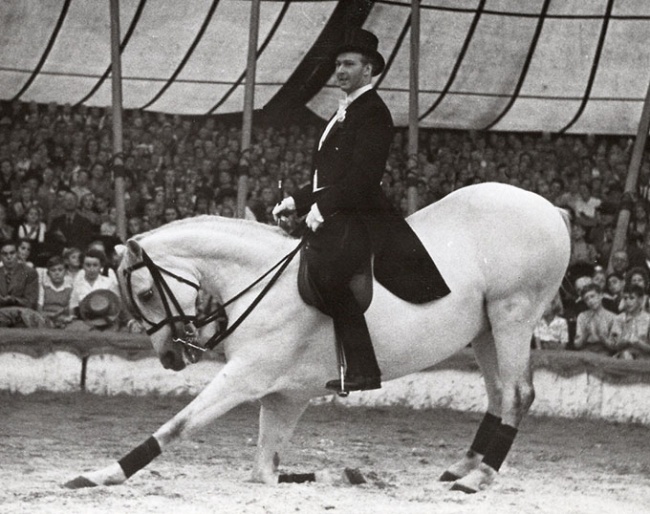
This article is a continuation of "Welcome to the Circus" - A New Series on Classical Dressage and the Circus
"Dressage Needs to be Visualised Love"
Whomever has seen Fredy Knie senior in the middle of his manège directing a group of horses, showing a horse in High School or the airs above the ground in hand, will not forget it, wether horse or layman. The calmness of man and horses alike, as well as the pride and satisfaction in their faces were as spectacular as the show acts themselves. This inner glow of horses showing high performances is something fascinating, but also something I very often miss watching top sport horses leave the arena.
It is something which has been continued by his son Fredy Junior and now great-grand-son Ivan Knie. It is invaluable in times in which the public gets more critical towards horses in sport or circus.
Child Star Fredy Knie Senior
Just one year after the brothers Friedrich, Rudolf, Charles and Eugen Knie founded the privately funded „Swiss National Circus“ and bought the first tent to replace the outdoor shows, Fredy Knie senior was born in 1920 in Geneva, a son of Friedrich Knie.

Oskar Frank
One would assume that after such a beginning the young boy would easily climb up the greasy pole in the years that came, but after some time Fredy senior lost his enthusiasm because he could not stand the way horses were usually trained at that time for circus performances : with lots of pressure and stingers.
In the end he was sent to the famous Oskar Frank of the Swiss Remount Depot in Thun who trained horses to Grand Prix level and to this date enjoys a respectable reputation of his own in Switzerland long after his death.
As mentioned in the book „Fredy Knie“ by Sigrid Eicher, Oskar Frank taught Fredy a lot about the theory of riding, but apparently little about the horse's nature. "He had several teachers, but only one who stamped him because he never hit horses," the late and famous TV journalist Horst Stern remarked in his much-noticed documentation "Bemerkung zum Pferd im Zirkus" (Remarks on the horse in the circus).
Rablo
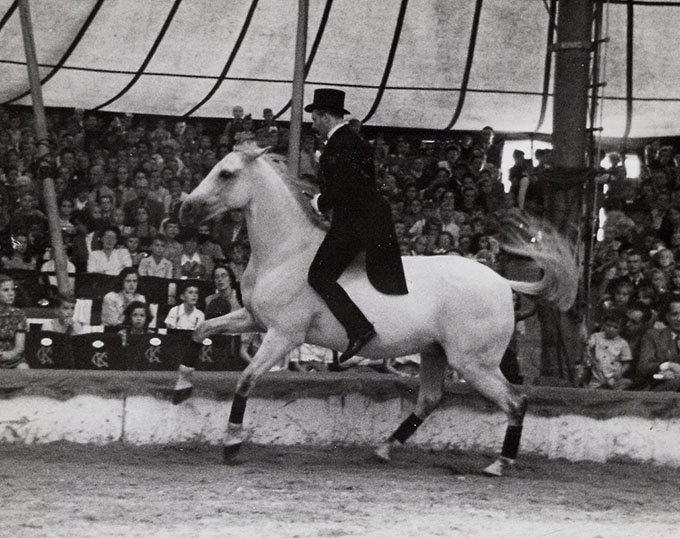
scratch. He shone with no tack in High School
movements.
A journey began. Knie’s main aim was never the show act, the movement, the trick. It was to train horses in a way that they kept their character and inner strength, or moral as some would describe it. And this seemed only possible if he found a way of communication which made violence completely dispensable.
Rablo was the first school horse Knie trained from scratch and he showed him in High School without saddle or bridle, an extraordinary testimony of the young man’s talent and dedication to an approach which put mutual trust and a true partnership first.
Classical Principles and Relaxation
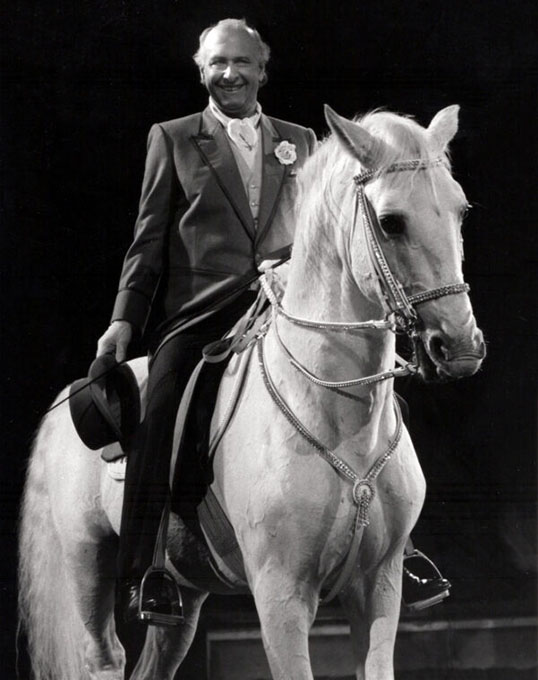
and Fredy Knie jr was an extraordinary High
School horse.
He exhibited between 1971
and 1984 and is pictured here during his
farewell from the manège.
At the beginning of the 1950s Fredy senior made a friendship which would last a lifetime and which would enrich his knowledge as much as that of his peer, Georg Wahl. Wahl had spent 10 years at the Spanish Riding School in Vienna and learnt from the school’s greatest, like Gottlieb Polak until his death. Both men learnt and complemented each other as both based their work on classical riding principles. No short cuts, no tricks, but instead patient small stepped work to get body and mind used to the challenges.
This was overall necessary as the work on the circle can otherwise be harmful. Knie always built up his young horses very carefully and suppled them thoroughly so that they remained fit and healthy until a high age. The longevity of their health also owed to the fact that the horses remained fresh in their minds and curious for their work. An art in itself!
Relaxation and Trust
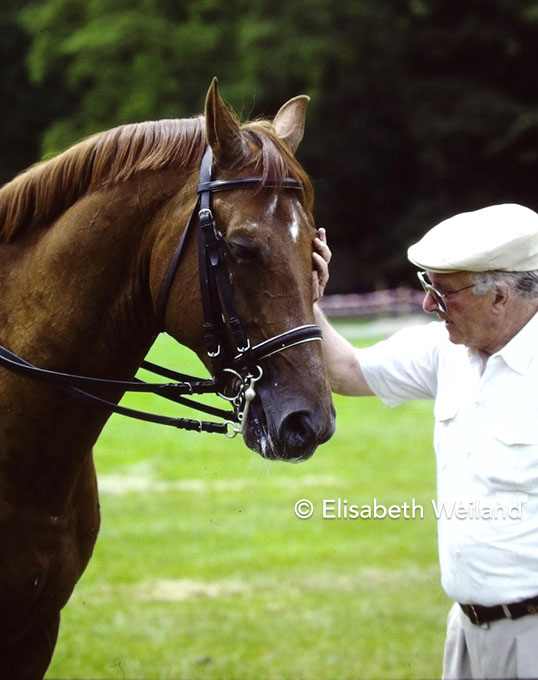
successful in-hand work.
Knie’s method was not only based on the absence of any violence, but also on praise: With the voice and with treats. If there were disharmonies he took great care to direct the training in a way that it could be finished positively, something already France’s great General L’Hotte recognized 100 years earlier: "The horse has to go back to the stables as happy as he left."
The Whip as The Baton
Fredy Knie senior was as outstanding with liberty work as with High School riding. Some of his horses showed the airs above the ground as excellently at those in Vienna at that time and what stunned the onlooker was the ease and motivation with which these horses showed these most difficult movements.
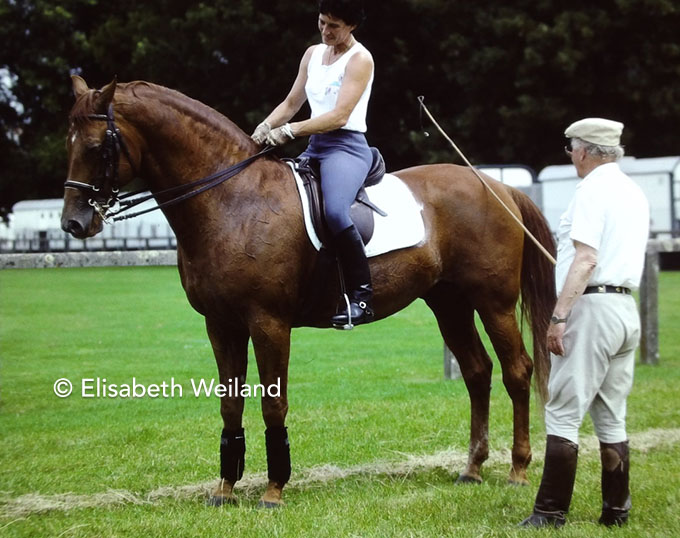
sure Afghadi remained relaxed when the whip
touched him. Only a relaxed horse is
able to learn and show a good piaffe which is
soft, light-footed and regular.
The whip was never used as a tool for punishment, only for helping the horse understand. The whip had to be viewed as the extended arm of the trainer. Knie spent considerable time to get the horses used to the whip. Therefore he kept a distance, stroked them all over their body with the whip and talked soothingly to them while doing so, until the horses were totally relaxed.
In Sigrid Eicher's book, Knie stressed that the reason why the piaffe is often a movement of fear for many horses is because of wrong in-hand work and wrong use of the whip. "In the past if a horse kicked after the whip due to fear, the trainer hit him which only increased the horse’s fear," Knie sr. stated.
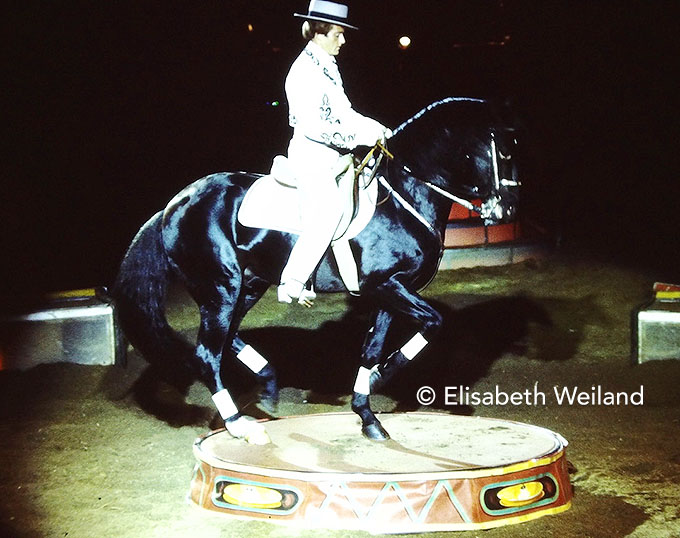
rhythmic and necessarily in place, demonstration
of the horse’s correct training and high degree
of collection and balance
For Knie himself collection was a relaxed horse in balance, able to show round and harmonious movements.
His use of the whip resembled a baton which a conductor uses to lead his orchestra. Some of those who call themselves dressage trainers, but do nothing else than stress their so-called piaffe steps out of their anxious horses, would do well to watch a few old videos of Knie to get an idea how little is necessary to get so much!
Circus and Dressage Competition
In our days it is not unusual that even gold decorated riders ask trainers for help to teaching their horses piaffe and passage. Back in the days this was rather uncommon. However, Fredy Knie senior’s mastership was so renowned that as of the late 1960s more and more competition riders approached him for help.

and with which intensity is an art only very few
trainers master. Knie sr helping Ruth Hunkeler
on Afghadi in her preparations for the 1992 Olympics
Fredy Knie senior appreciated working with these competition riders, and now and then was even seen at national or international shows, like for example the 1976 CDI in Paris or at Donaueschingen.
He himself, as an extremely busy professional, never competed in a dressage arena. However, in 1977 Knie’s outstanding work with horses got recognised and Fredy was awarded the Golden Clown during the circus festival in Monte-Carlo. Founded in 1974 by the late Count Rainier III. of Monaco the so-called „Circus Oscar“ is the most valuable award an artist can win.
Fredy Knie senior’s equally talented son Fredy junior got this honour in 1996 after his daughter Geraldine had won a Silver Clown three years earlier. Only recently, in 2020, Geraldine’s 21-year-young son Ivan, together with Maycol and Woiris Errani, took a Golden Clown for their horse act.
Open Doors
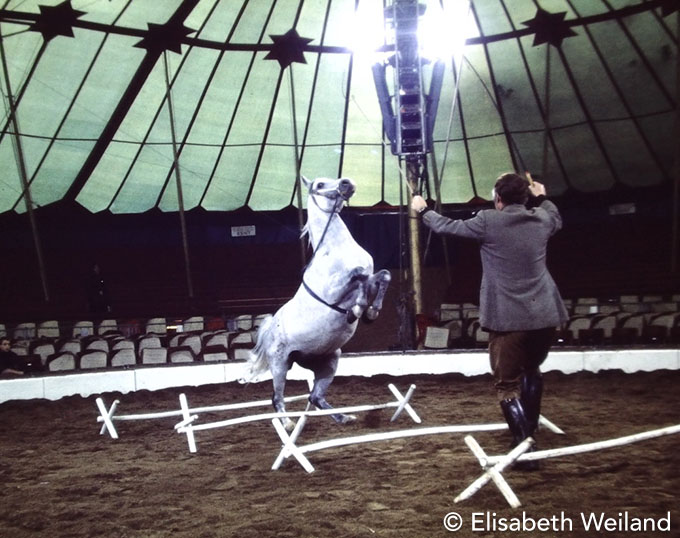
to do. The Arab stallion was a fantastic courbetteur
and jumped over several cavaletti in the most
classical manner.
At Knie the doors were never closed. As early as 1938 Circus Knie opened doors to the public and they could attend the daily morning training (for free). Fredy Knie senior, then only 18 years of age, aimed to show everybody the way he trained animals and he also called the public the reason for his self-discipline. he wanted to set a good example with the work he showed publicly at any time.
This tradition has not changed when his son Fredy Knie junior took over and it is upheld by junior’s daughter Geraldine who’s now responsible for the circus’ artistic part. Even in this day and age of social media, they have nothing to hide!
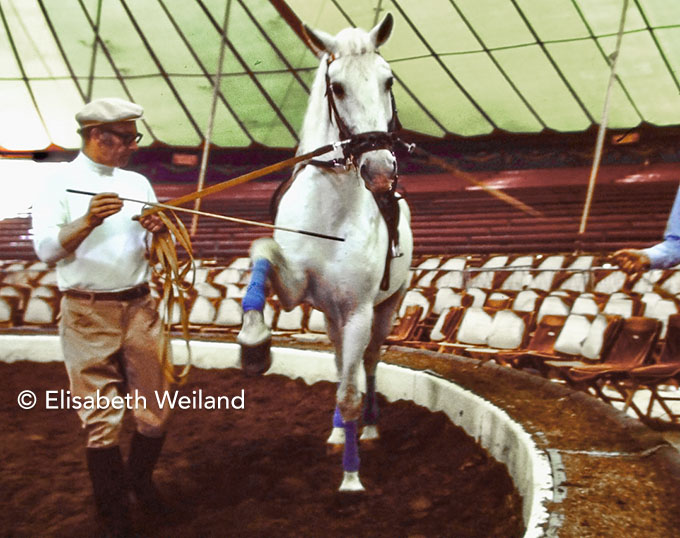
the horses are not afraid of their use to indicate what
they should do. This Lipizzan’s face speaks volumes
for a training which fostered his inner strength
and kept his interest.
The reproach often heard that training horses for the circus is against their nature and asks unnatural movements from them, is untenable at Circus Knie. Fredy Knie senior, his son Fredy junior, and his successors never based any of the movements on anything else than original, natural behaviour, even if the end result may (have) look(ed) quite differently.
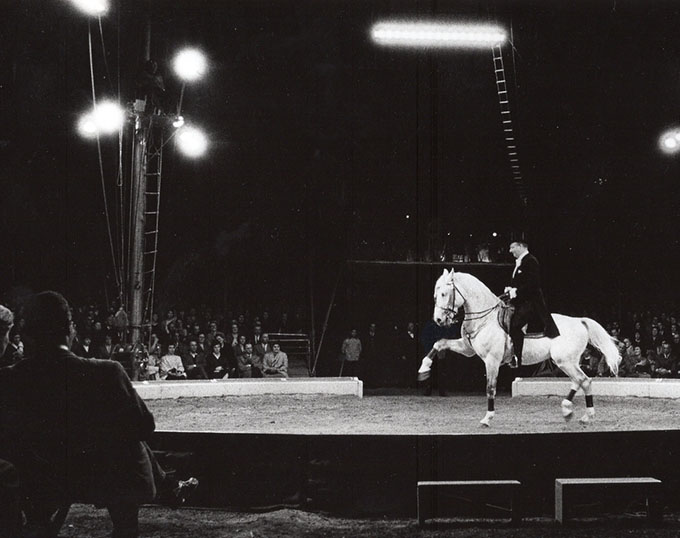
These are proven facts which nowadays are even more important than in the 1970s when Stern’s documentary was shot over many weeks.
Coming soon Part III Georg Wahl
By Silke Rottermann for eurodressage.com
Photos kindly provided with permission of Knie Media and Ulrich Lehmann for Eurodressage, as well as © Elisabeth Weiland
Related Link
"Welcome to the Circus" - A New Series on Classical Dressage and the Circus